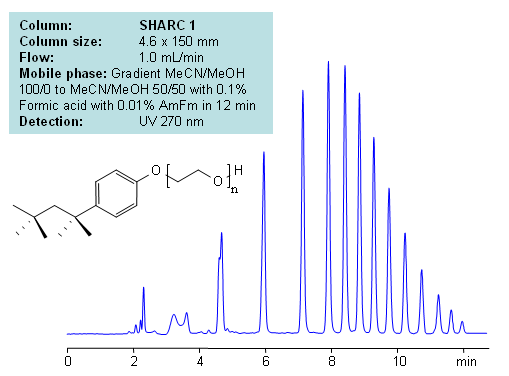
Triton X-100 is a non-ionic surfactant which has a hydrophilic polyethylene oxide group (on average it has 9.5 ethylene oxide units), and a hydrocarbon lipophilic or hydrophobic group. SHARC 1 HPLC columns are used to separate oligomers of Triton X-100. Separation is achieved in anhydrous conditions by hydrogen bonding using acetonitrile (ACN) and methanol (MeOH) as the mobile phase with formic acid and ammonium formate (AmFm) as buffer. This method can be used in determination of oligomers of Triton X-100 in detergents, liquid, paste, and powdered cleaning formulations. This separation can be monitored with almost any detection technique (UV, ELSD, LC/MS, RI, CAD, etc.)
| Column | Sharc 1, 4.6×150 mm, 5 µm, 100A |
| Mobile Phase | Gradient MeCN/MeOH – 100/0- 50/50%, 12 min |
| Buffer | Formic Acid 0.1% , AmFm – 0.01% |
| Flow Rate | 1.0 ml/min |
| Detection | UV, 270 nm |
| Class of Compounds |
Nonionic Surfactant, Hydrophobic, Ionizable |
| Analyzing Compounds | Triton-X-100 |
Application Column
SHARC 1
The SHARC™ family of innovative columns represents the first commercially available columns primarily utilizing separation based on hydrogen bonding. SHARC stands for Specific Hydrogen-bond Adsorption Resolution Column. Hydrogen bonding involves an interaction or attraction between a bound hydrogen atom and molecules containing electronegative atoms, such as oxygen, nitrogen, and fluorine.
Select options




